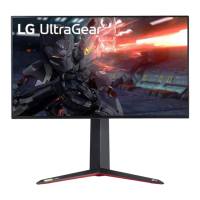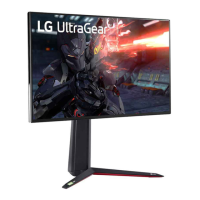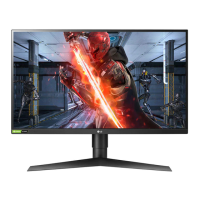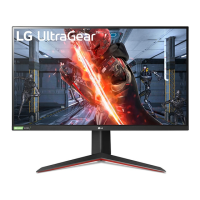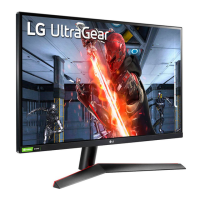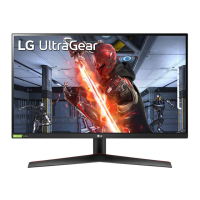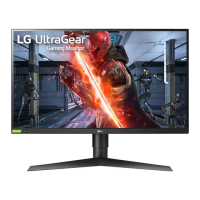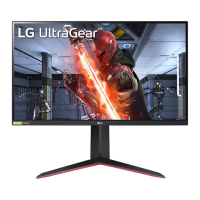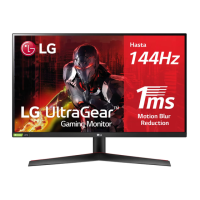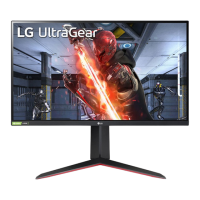Do you have a question about the LG UltraGear 27GN950 and is the answer not in the manual?
Defines HDMI trademarks and logos.
Identifies SuperSpeed USB Trident logo as a registered trademark.
Lists VESA and DisplayPort trademarks owned by VESA.
Identifies Waves MaxxAudio and Maxx marks as trademarks.
Provides URL to obtain open source code and license terms.
Emphasizes using genuine LG components for safety and performance.
Warns that warranty is void if unauthorized components are used.
Notes that illustrations may differ from the actual product.
Advises against applying foreign substances to screw parts during assembly.
Warns against applying excessive force when tightening screws to prevent damage.
Instructs not to carry the monitor upside down by holding only the base.
Advises not to touch the monitor screen when lifting or moving.
Explains the wave pattern appearance as a result of glittering material.
Informs that components might look different from illustrations.
States that product information and specifications are subject to change.
Guides users on how to purchase optional accessories.
Mentions that the power cord may vary by region.
Instructs to download drivers and software from the LGE website.
Explains how to control monitor functions using the joystick button.
Describes how to turn on the monitor using the joystick button.
Details how to turn off the monitor by holding the joystick button.
Explains volume control using the joystick button's left/right movement.
Explains brightness control using the joystick button's up/down movement.
Explains how to control monitor functions using the lighting button.
Describes changing backlight colors with the lighting button.
Details turning off the backlight by holding the lighting button.
Explains controlling backlight brightness with the lighting button.
Notes the location of the joystick and lighting buttons.
Informs that the lighting function works during power saving or when the screen is off.
Provides instructions to prevent damage when moving or lifting the monitor.
Recommends using original packaging for moving.
Advises disconnecting all cables before moving or lifting the monitor.
Instructs to hold the monitor frame, not the panel itself.
Advises keeping the screen facing away to prevent scratches.
Warns against exposing the monitor to shock or vibration during transport.
Instructs to keep the monitor upright during movement.
Caution to avoid touching the monitor screen to prevent damage.
Warns about instability and potential damage when using without the stand.
Guides on placing the monitor upright on a table.
Specifies a 100 mm clearance from the wall for ventilation.
Warns of electric shock risk and advises unplugging the power cord.
Advises using the provided power cord and a grounded outlet.
Steps for adjusting monitor height safely.
Warns against holding the lower frame to prevent finger injury during height adjustment.
Steps for adjusting the monitor screen angle.
Specifies the adjustable screen angle range (-5° to 15°).
Caution to avoid touching or pressing the screen during angle adjustment.
Explains the monitor's 90° clockwise pivot capability.
Warns against fast or forceful rotation during pivot.
Caution to prevent finger injury when pivoting the monitor.
Instructs to raise the monitor to maximum height before pivoting.
Guides on adjusting the monitor angle before pivoting.
Details the clockwise rotation step for the pivot feature.
Instructs on completing the 90° pivot installation.
Notes that the Auto Pivot feature is not supported.
Mentions using Windows shortcut keys for screen rotation.
Directs users to Kensington's resources for lock information.
Explains how to connect the monitor using the Kensington security cable.
States that the Kensington security system is optional.
Confirms monitor compatibility with wall mount specifications.
Specifies 100 mm clearance from wall and sides for ventilation.
Advises obtaining detailed installation instructions from a local retail store.
Explains attaching an optional wall mounting bracket to the monitor.
Emphasizes securely fixing the wall mount bracket to the monitor and wall.
Recommends using VESA standard screws for mounting.
States that the wall mount kit contains installation guides and parts.
Notes that the wall mounting bracket is optional.
Warns that longer screws may damage the product's interior.
Advises against applying excessive force when mounting the wall plate.
Instructs to remove the stand before wall mounting.
Warns of electric shock risk during installation and advises unplugging.
Warns of injury risk from monitor falling if installed on a slanted wall.
Emphasizes secure attachment to the wall as per instructions to prevent injury.
Warns that excessive force during screw tightening can damage the monitor.
Advises using VESA-compliant mounting brackets and screws.
Specifies a maximum screw length of 8 mm from the monitor back.
Informs that manual illustrations may differ from the actual product.
Guides on how to select the input option via settings.
Warns about using uncertified generic cables.
Advises against pressing the screen for extended periods.
Warns about image retention from static images and suggests screensavers.
Advises using grounded power sources for the power cord.
Explains that monitor flickering in low temperatures is normal.
Notes that colored spots on the screen are normal for LCD.
Explains the Plug and Play feature for easy device connection.
Warns about potential compatibility issues with DVI/DP to HDMI cables.
Recommends using certified HDMI cables for proper display.
Suggests using High Speed HDMI cables, with or without Ethernet.
Notes that DP version can affect video/audio output.
Guides on using appropriate cables for Mini DisplayPort graphics cards.
Explains HDMI connection for AV devices.
Explains the monitor's USB port functionality as a hub.
Guides on connecting for USB 3.0 functionality.
States that connected USB devices can be controlled via PC.
Advises updating Windows before using the product.
Informs that peripheral devices are not included.
Warns that some USB devices may not be supported or function correctly.
Suggests using powered USB hubs or HDDs for better compatibility.
Explains connecting headphones via the monitor's port.
Notes potential limitations on audio functions based on settings.
Recommends straight earphones to avoid connection problems.
Informs that the OSD may differ slightly from the manual's illustrations.
Guides on how to access the main menu using the joystick button.
Explains how to navigate and set options within the menu.
Describes how to exit the main menu by pressing the joystick button.
Explains enabling the main menu by pressing the button.
Details turning off the monitor by holding the button for 5 seconds.
Explains volume adjustment using joystick left/right.
Guides on navigating to [Input] or [Settings] features.
Explains brightness adjustment using joystick up/down.
Describes turning off monitor or entering Game Mode with joystick.
Details the function mapping of joystick directions to menu options.
Instructs how to access the OSD menu.
Explains joystick use for setting menu options.
Guides on navigating within and exiting sub-menus.
Shows the path to access Game Mode settings.
Details game modes optimized for SDR signals.
Explains saving custom display settings for games in Gamer modes.
Describes the FPS mode optimized for dark FPS games.
Describes the RTS mode optimized for RTS games.
Explains the Vivid mode for enhanced color vibrancy.
Describes the Reader mode for comfortable document viewing.
Explains the HDR Effect mode for high dynamic range optimization.
Describes the sRGB mode for standard color space.
Explains calibration modes for adjusting to previous screen calibrations.
Details game modes optimized for HDR signals.
Notes potential HDR display issues based on Windows settings.
Warns that HDR function performance can depend on graphics card capabilities.
Explains the Overclock feature for increasing refresh rate.
Describes Adaptive-Sync/FreeSync for smooth visuals by synchronizing frequencies.
Advises adjusting refresh rate in GPU control panel after rebooting with Overclock on.
Instructs to disable Overclock if display issues occur.
States that Overclock requires a DisplayPort connection.
Notes that Overclock performance can vary based on hardware and content.
Lists supported interfaces for Adaptive-Sync/FreeSync.
Specifies the need for a compatible NVIDIA or AMD graphics card for Adaptive-Sync.
Recommends updating graphics card drivers for Adaptive-Sync.
Explains Black Stabilizer for improving visibility in dark game scenes.
Details response time settings for different viewing conditions.
Recommends response time settings and warns about image sticking with [Faster].
Details the available response time settings.
Explains the Cross Hair feature for FPS games and its customization.
Notes that the Cross Hair feature automatically turns off in power saving modes.
Explains how to reset game settings to their defaults.
Explains how to adjust screen brightness.
Explains how to adjust screen contrast.
Explains how to adjust screen sharpness.
Details gamma settings and their effect on image brightness.
Explains color temperature adjustment options.
Describes custom color adjustment for R/G/B.
Explains customizing picture color via RGB adjustments.
Details hue and saturation adjustments for six specific colors.
Explains hue adjustment for screen color tone.
Describes saturation adjustment for color intensity.
Explains Black Level setting for HDMI, controlling the darkest color.
Details [High] and [Low] options for Black Level.
Explains the DFC feature for automatic brightness adjustment.
Guides on resetting picture settings to defaults.
Explains how to select the monitor's input source.
Details how to adjust the aspect ratio of the screen.
Describes aspect ratio options like Full Wide, Original, and Just Scan.
Explains the Auto Input Switch feature for automatic source switching.
Guides on selecting sound equipment for Waves MaxxAudio®.
Explains how to disable the Waves MaxxAudio® feature.
Guides on changing the OSD menu language.
Explains the SMART ENERGY SAVING feature for power conservation.
Details the [High], [Low], and [Off] settings for energy saving.
Notes that energy saving data can vary by panel supplier.
Explains settings for backlighting behavior when the monitor is off.
Guides on enabling or disabling the power LED.
Explains the Automatic Standby feature for power saving.
Explains the HDMI ULTRA HD Deep Color feature for enhanced image quality.
Guides on enabling and ensuring compatibility for HDMI ULTRA HD Deep Color.
Provides a table detailing 4K @ 60 Hz support formats.
Guides on setting the DisplayPort version to match the connected device.
States the requirement of a DSC-compatible graphics card for 144 Hz+ display.
Recommends DP versions 1.4(DSC) or 1.4 for HDR usage.
Explains Local Dimming for contrast enhancement.
Details the [On], [Auto], and [Off] options for Local Dimming.
Explains Variable Backlight feature and potential halo effect.
Notes Variable Backlight is for HDR content and should be off when not gaming.
Lists settings for Variable Backlight based on usage type.
Explains how to set the power-on buzzer sound.
Describes OSD Lock, which restricts menu adjustments.
Explains the Information display showing power time and resolution.
Guides on resetting all monitor settings to initial values.
Provides checks for when the screen displays nothing.
Helps diagnose issues based on Power LED status.
Explains the 'not recommended resolution' message and its cause.
Explains the 'No Signal' message and how to resolve it.
Explains the 'Out of Range' message and its cause.
Guides on resolving issues with 3840x2160 resolution availability.
Advises checking graphics card DSC support for high resolutions.
Recommends updating graphics card drivers to the latest version.
Explains that OSD Lock can disable certain menu functions.
Guides on resolving 'Unrecognized monitor' messages by installing drivers.
Explains image retention caused by prolonged display of static images.
Advises selecting the correct resolution for stable display.
Explains flickering caused by interlaced resolutions and suggests alternatives.
Defines vertical frequency (refresh rate) in Hz.
Defines horizontal frequency in kHz.
Advises checking graphics card resolution/frequency against monitor specifications.
Explains potential display issues from incorrect resolution settings.
Notes that some graphics cards may not support 3840 x 2160 resolution.
Guides on setting color quality to 24-bit or higher for color issues.
Provides checks for unstable or monochrome display issues.
Clarifies that pixilated spots on LCD screens are normal.
Guides on troubleshooting no sound from the headphone port.
Provides checks for the backlighting not turning on.
States that the monitor supports 10-bit color depth.
Details the maximum resolutions supported via HDMI and DisplayPort.
Specifies the recommended resolutions for HDMI and DisplayPort.
Provides specifications for the included AC/DC adapters.
Details the environmental conditions for monitor operation.
Details the environmental conditions for monitor storage.
Lists the monitor's dimensions with and without the stand.
Lists the monitor's weight with and without the stand.
Indicates the monitor's power rating.
Details power consumption levels in different operating modes.
Table detailing supported resolutions and frequencies for HDMI/DP.
Mentions HDMI support for FreeSync Premium Pro.
Indicates resolutions and frequencies exclusive to DisplayPort.
Mentions DisplayPort support for Overclock mode at 160 Hz.
Reemphasizes the DSC requirement for 144 Hz+ display via DisplayPort.
Table detailing supported video resolutions and frequencies for HDMI.
| Color gamut | 98 % |
|---|---|
| Pixel pitch | 0.1557 x 0.1557 mm |
| Screen shape | Flat |
| Backlight type | W-LED |
| Display diagonal | 27 \ |
| Display technology | LED |
| Native aspect ratio | 16:9 |
| Contrast ratio (typical) | 1000:1 |
| Display number of colors | 1.073 billion colors |
| Display brightness (typical) | 400 cd/m² |
| Supported graphics resolutions | 3840 x 2160 |
| High Dynamic Range (HDR) supported | Yes |
| High Dynamic Range (HDR) technology | HDR Effect, High Dynamic Range 10 (HDR10) |
| Dynamic contrast ratio marketing name | Mega Contrast |
| Built-in camera | - |
| Product color | Black |
| Market positioning | Gaming |
| DisplayPort version | 1.4 |
| Headphone connectivity | 3.5 mm |
| Number of upstream ports | 1 |
| USB Type-C downstream ports quantity | 2 |
| Tilt angle range | -5 - 15 ° |
| Panel mounting interface | 100 x 100 mm |
| AC input voltage | 100 - 240 V |
| AC input frequency | 50 - 60 Hz |
| Energy efficiency scale | A to G |
| Power consumption (off) | 0.3 W |
| Power consumption (standby) | 0.5 W |
| Depth (with stand) | 291.2 mm |
|---|---|
| Width (with stand) | 609.2 mm |
| Height (with stand) | 570.6 mm |
| Weight (with stand) | 7700 g |
| Depth (without stand) | 53.7 mm |
| Height (without stand) | 352.9 mm |
| Weight (without stand) | 5700 g |

